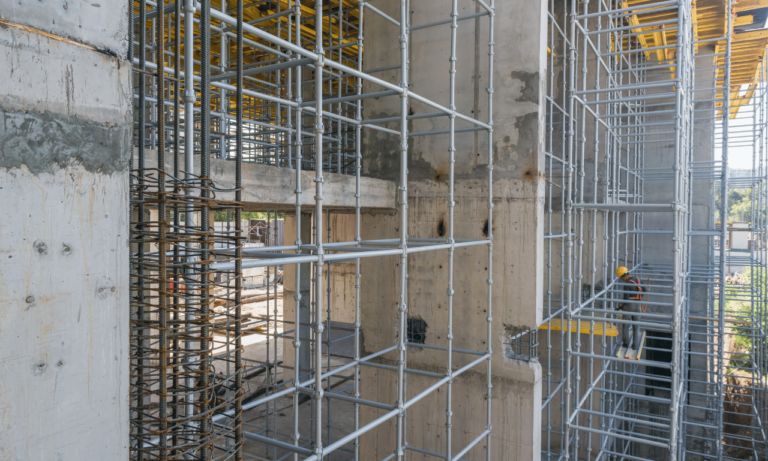Phone:
(+65)8319-0742
When it comes to construction site safety in the construction industry, accurate scaffolding load calculations are essential. Understanding the capacity of scaffolding and calculating the scaffold load capacity are crucial steps in preventing accidents and maintaining a secure working environment. Compliance with scaffold weight limit regulations is also necessary to ensure the overall safety of the site.
Key Takeaways:
- Accurate scaffolding load calculations are crucial for construction site safety.
- Understanding scaffolding weight limits and load capacity is essential to prevent accidents.
- Compliance with scaffold weight limit regulations is necessary for overall site safety.
- Calculating scaffold loads requires consideration of various factors.
- Proper distribution of loads across the scaffolding helps maintain stability.
Understanding Scaffolding Load Capacity
When it comes to ensuring the safety of scaffolding structures, understanding the load capacity is of utmost importance. To calculate the load capacity accurately, several factors need to be taken into consideration, including scaffold design criteria and a load calculations formula. Additionally, the loading capacity of scaffolding must be assessed to ensure it can support the anticipated loads.
scaffold design criteria play a crucial role in determining the load capacity. This includes considering the material strength, structural integrity, and support system of the scaffolding. By ensuring that these criteria are met, the scaffolding can withstand the maximum load it is designed for, providing a safe working environment.
In addition to design criteria, a load calculations formula is used to determine the maximum load that the scaffolding can handle. This formula takes into account various factors such as the weight of workers, tools, and construction materials. By using this formula, construction professionals can ensure that the scaffolding is not overloaded, reducing the risk of accidents. The maximum load capacity of scaffolding must be carefully calculated to ensure safety.
Understanding the factors that contribute to scaffolding load capacity is vital for maintaining a safe construction site. By adhering to scaffold design criteria and using load calculations formulas, construction professionals can ensure that the scaffolding is built to withstand the maximum load and provide a secure working platform for workers. The safe working load (SWL) of scaffolding must be determined to prevent structural failure and ensure worker safety.
Example Table: Scaffold Design Criteria
| Design Criteria | Description |
|---|---|
| Material Strength | The strength and durability of the materials used in the construction of the scaffolding. |
| Structural Integrity | The overall stability and robustness of the scaffolding structure. |
| Support System | The system of support and bracing used to reinforce the scaffolding. |
By considering these design criteria and using load calculations formulas, construction professionals can ensure that the scaffolding is designed and built to handle the maximum load it may encounter. This is crucial for creating a safe and secure working environment on construction sites.
Importance of Scaffolding Weight Limits

When it comes to scaffolding, weight limits are not just arbitrary numbers. They play a critical role in ensuring the overall safety and stability of the structure. Exceeding these weight limits can have severe consequences, including instability, collapse, and even serious accidents. It is therefore vital to understand the importance of adhering to scaffolding weight limits and the safety factors associated with them. The safety factor in scaffolding, generally ranging from 2 to 4, ensures that the scaffold can support significantly more weight than the maximum intended load.
Scaffolding Safety Factors
When determining the weight limits of scaffolding, several safety factors come into play. These factors consider various elements that can impact the structural integrity of the scaffolding, such as wind loads, working loads, and live loads. Wind loads, for example, account for the forces exerted on the scaffolding due to wind pressure. Working loads encompass the weight of workers, equipment, and tools, while live loads take into account any additional loads that may be present during construction activities.
By carefully considering these safety factors, construction professionals can determine the appropriate weight limits for their scaffolding systems. This ensures that the scaffolding can withstand the anticipated loads and maintain stability throughout the duration of the project.
Adhering to these weight limits is of utmost importance. It not only protects the workers who rely on the scaffolding’s structural integrity but also helps maintain a secure construction site. Without adhering to the weight limits, the risk of accidents and structural failures increases significantly, posing a threat to the well-being of everyone involved.
As a responsible construction professional, it is crucial to prioritize the adherence to scaffolding weight limits. By doing so, you demonstrate a commitment to the safety of your team and the success of your construction projects.

Understanding Scaffolding Load Capacity
Scaffolding load capacity refers to the maximum weight that a scaffold can safely support without compromising its integrity. This is a critical aspect of construction safety, as exceeding the load capacity can lead to structural failure, collapses, and serious accidents. The load capacity of a scaffold depends on various factors, including the type of scaffold, materials used, and environmental conditions. By understanding the load capacity, construction professionals can ensure that the scaffold can safely support the maximum weight it is designed for, thereby providing a secure working environment.
Safety Measures and Regulations
To ensure the safety of scaffolding systems, OSHA regulations mandate that they be designed and constructed to support at least four times the maximum intended load. The maximum intended load includes the combined weight of all workers, their hand tools and equipment, and all materials being used at any given time. This stringent requirement helps prevent overloading and potential structural failures. Additionally, employers must ensure that scaffolding is inspected regularly by a competent person to maintain its safety. Regular inspections help identify any potential issues and ensure that the scaffold remains in good condition throughout the project.
Load Capacity Calculations
Calculating the load capacity of a scaffold involves determining the maximum weight that the scaffold can safely support. This can be done by multiplying the base rating of the scaffold by the area of the work platform. The base rating is typically measured in pounds per square foot, and the area of the work platform is measured in square feet. For example, a medium-duty scaffold with a base rating of 50 pounds per square foot and a work platform area of 100 square feet would have a load capacity of 5,000 pounds. By accurately calculating the load capacity, construction professionals can ensure that the scaffold can safely support the intended load without risking structural failure.
Scaffold Design and Load Capacity
Scaffold design plays a critical role in determining its load capacity. The type of scaffold, materials used, and configuration of the scaffold all impact its load-bearing capacity. For example, a heavy-duty scaffold with a sturdy frame and robust materials can support more weight than a light-duty scaffold with a lighter frame and less robust materials. Additionally, the design of the scaffold must take into account the intended load and the environmental conditions in which it will be used. By carefully considering these factors, construction professionals can select the appropriate scaffold design to safely support the required load.
Load Distribution and Material Selection
Proper load distribution across the scaffold is crucial to ensure that the load capacity is not exceeded. Concentrated loads can put excessive stress on the scaffold, leading to structural failure. Therefore, it is essential to distribute the weight evenly across the scaffold. Material selection is also critical, as high-strength materials can handle more weight, but they also come at a higher cost. It’s essential to strike a balance between strength and budget when selecting scaffold materials. By ensuring proper load distribution and selecting appropriate materials, construction professionals can maximize the load capacity of the scaffold and maintain a safe working environment.
Calculating Scaffold Loads: Best Practices

To ensure the safety and structural integrity of scaffolding, accurate calculation of scaffold loads is of utmost importance. By considering various factors and following best practices for calculating scaffold loads, you can maintain stability and minimize the risk of accidents.
When calculating scaffold loads, it is essential to take into account the anticipated weight of workers, tools, equipment, and construction materials. Each element contributes to the overall load and must be carefully evaluated to ensure the scaffold can safely support the work being performed.
Proper distribution of the load across the scaffolding is crucial for maintaining stability. Uneven distribution can lead to imbalances and potential structural failure. By evenly distributing the load, you can ensure that the weight is properly supported and minimize the risk of overloading.
Following best practices for calculating scaffold loads will help you achieve accurate and reliable results. These practices include:
- Consulting the scaffold manufacturer’s guidelines and specifications for load capacities
- Taking into consideration any additional factors such as wind loads and dynamic loads
- Using appropriate load calculation formulas and equations
- Regularly inspecting the scaffolding for any signs of stress, deformation, or damage
By implementing these best practices, you can ensure that your scaffold loads are calculated accurately and that the structure remains safe and secure.
Remember, scaffold weight calculation is crucial for maintaining safety on construction sites. Adhering to these best practices will help minimize the risk of accidents and ensure compliance with regulations.
Load Calculation Example
| Load Type | Weight (lbs) |
|---|---|
| Workers | 600 |
| Tools and Equipment | 400 |
| Construction Materials | 800 |
| Total Load | 1800 |





Practical Tips
Use Manufacturer Data
Many scaffolding manufacturers provide weight charts for standard lengths of tubing, standard boards, couplers, frames, etc. Check these to streamline your calculation.Density Values
- Steel typically ~7850 kg/m³
- Aluminum scaffolding tubes can be ~2700 kg/m³
- Wood density varies widely (400–900 kg/m³), so check the type of wood used.
Safety Factors
When calculating or checking scaffolding weight (and load capacity), always consider safety standards and applicable codes (like OSHA in the U.S. or EN 12811 in the EU). Include factors of safety for dynamic loads, wind loads, and any additional live loads on the structure.Always Verify
These formulas give theoretical or approximate results. Real-world connections, manufacturer tolerances, and in-field variations can affect actual weight.
Scaffold Load Rating: Capacity, Weight, and Occupational Safety
Scaffolding is an essential component in construction and maintenance industries, providing the necessary platform for workers to perform tasks at elevated heights. Understanding the load rating of scaffolds is crucial for ensuring safety and efficiency. This article delves into scaffold load rating, exploring its capacity, weight limits, and the standards established to ensure occupational safety.
What is Scaffold Load Rating and Why is it Important?
Defining Scaffold Load Rating and Capacity
The scaffold load rating refers to the maximum weight a scaffold can safely support while maintaining structural integrity. It encompasses the capacity of the entire scaffold system, including scaffold planks and platforms. This rating is crucial as it determines how much weight a scaffold can safely handle, ensuring that workers and materials remain secure during operations.
Importance of Load Rating in Scaffold Safety
Load ratings are fundamental to scaffold safety because they prevent overloading, which could lead to catastrophic failures. Adhering to the rated load capacity ensures that the scaffold structure remains stable under the pressure of workers and materials. Without proper attention to load ratings, the risk of accidents increases significantly, posing severe threats to occupational safety.
Types of Scaffold and Their Load Ratings
Scaffolds come in various types, each with distinct load ratings. For instance, light-duty scaffolds are designed to handle a maximum of 25 pounds per square foot, making them suitable for tasks involving minimal weight. Medium-duty scaffolds can support up to 50 pounds per square foot, while heavy-duty scaffolds are rated for 75 pounds per square foot. Understanding these classifications helps in choosing the appropriate scaffold for specific tasks.
How Much Weight Can a Scaffold Safely Support?
Understanding Maximum Intended Load
The maximum intended load includes the total weight of workers, tools, materials, and any additional equipment on the scaffold. It is crucial to calculate this load accurately to ensure the scaffold can safely support the weight without exceeding its capacity.
Factors Affecting Scaffold Weight Limits
Several factors influence scaffold weight limits, including the type of scaffold, the quality of materials used, and environmental conditions. For example, a scaffold designed and constructed for indoor use might not withstand harsh outdoor environments. Additionally, scaffold components like planks and platforms must be checked for wear and tear, which can compromise their load-bearing capacity.
Calculating Safe Load for Various Scaffold Types
To determine the safe load for different scaffold types, consider the rated load capacity and the maximum intended load. For example, if a scaffold is rated at 50 pounds per square foot and measures 10 feet by 10 feet, the total safe load capacity would be 5,000 pounds. Ensuring these calculations align with the scaffold’s specifications is vital for maintaining scaffold safety.
What are OSHA Requirements for Scaffold Load Limits?
Overview of OSHA Regulations on Scaffold Safety
The Occupational Safety and Health Administration (OSHA) sets stringent guidelines to ensure scaffold safety. These regulations, outlined in 1926 Subpart L, cover various aspects of scaffold design, construction, and use, emphasizing the importance of adhering to load limits to prevent accidents.
Understanding OSHA’s Scaffold Load Capacity Guidelines
OSHA’s guidelines specify that scaffolds must be capable of supporting at least four times the maximum intended load. This requirement ensures a significant safety margin, accounting for unforeseen variables that might increase the weight a scaffold supports.
Ensuring Compliance with OSHA Load Rating Standards
Compliance with OSHA load rating standards involves regular inspections and maintenance of scaffolding equipment. Ensuring that all scaffold components, from planks to guardrails, meet the regulatory standards helps in maintaining a safe working environment. Employers must also provide appropriate training to workers regarding load limits and scaffold safety protocols.
How Do Scaffold Components Affect Load Capacity?
Role of Scaffold Planks and Platforms in Load Bearing
Scaffold planks and platforms are critical in distributing the load uniformly across the scaffold structure. The quality and condition of these components directly affect the scaffold’s load capacity. A defective plank can significantly deflect under pressure, compromising the entire scaffold system’s stability.
Ensuring All Scaffold Components Can Support the Load
Every scaffold component, from the smallest bolt to the largest platform, must be assessed for its load-bearing capability. Components must be designed and constructed to handle the maximum load, ensuring that they do not fail under stress. Regular checks and maintenance are essential to verify that each part can support its share of the weight.
Common Mistakes in Scaffold Component Selection
One common mistake in selecting scaffold components is overlooking the importance of uniform load distribution. Using components incompatible with the scaffold’s design can lead to uneven weight distribution and potential failure. It’s crucial to choose components that meet the specific requirements for scaffold load capacity, ensuring safety and efficiency.
What Safety Measures Should Be Taken to Prevent Scaffold Overloading?
Identifying Signs of Potential Overloading
Signs of overloading include excessive deflection of planks, unusual creaking sounds, and visible stress marks on scaffold components. Recognizing these signs early can prevent accidents, allowing for timely interventions to reinforce or unload the scaffold.
Implementing Best Practices for Scaffold Safety
Best practices for scaffold safety involve regular training, clear communication of load limits, and strict adherence to safety protocols. Workers should be equipped with a personal fall arrest system and informed about the correct usage of scaffolding equipment. These measures help in minimizing the risk of scaffold overloading.
Regular Inspection and Maintenance of Scaffolding
Routine inspections and maintenance of scaffolding are crucial for identifying potential issues before they escalate. Ensuring that all components are in good condition and that the scaffold system is functioning correctly can prevent overloading, thereby safeguarding workers and maintaining a safe workplace.
Conclusion
Proper scaffolding load calculations are crucial for maintaining a safe working environment on construction sites. By understanding and adhering to scaffold weight limits, calculating load capacity, and distributing loads correctly, the risk of accidents and structural failure can be significantly minimized.
Adhering to scaffold weight limit regulations is essential not only for compliance but also for ensuring the safety and stability of the structure. Exceeding weight limits can lead to instability, collapse, and serious accidents. Therefore, it is vital to consider various factors such as wind loads, working loads, and live loads when determining the weight limits.
Implementing best practices for scaffold load calculations should be a priority for all construction projects. Accurate calculation of scaffold loads requires careful consideration of factors such as the anticipated weight of workers, tools, equipment, and construction materials. Properly distributing the load across the scaffolding is crucial to maintaining stability and avoiding overloading.
In conclusion, by following proper scaffold load calculations and adhering to weight limit regulations, construction sites can ensure the safety of workers and prevent potential accidents. Prioritizing accurate load calculations and load distribution is essential for maintaining a secure and productive construction environment.
FAQ
What are scaffolding load calculations?
Scaffolding load calculations refer to the process of determining the weight limits and load capacity of a scaffold. These calculations help ensure that the scaffold can safely support the anticipated loads, including workers, tools, equipment, and construction materials.
Why are scaffolding weight limits important?
Scaffolding weight limits are crucial for maintaining the stability and safety of the structure. Exceeding these limits can lead to collapse and serious accidents. Adhering to weight limits ensures a secure working environment and protects the workers.
How do I calculate the load capacity of a scaffold?
Calculating the load capacity of a scaffold involves considering various factors, such as material strength, structural integrity, and support system. A load calculations formula is used to determine the maximum load that the scaffold can withstand. It is essential to follow these calculations to maintain a safe working environment.
What are the best practices for calculating scaffold loads?
When calculating scaffold loads, it is important to consider the anticipated weight of workers, tools, equipment, and construction materials. Proper distribution of the load across the scaffold is vital for stability. Following best practices for load calculations ensures the scaffolding can safely support the work being performed.
Why is compliance with scaffold weight limit regulations important?
Compliance with scaffold weight limit regulations is crucial for maintaining a safe construction site. These regulations are designed to protect the workers and prevent accidents. Adhering to weight limits specified in the regulations helps ensure the stability of the scaffold and the overall safety of the site.




















